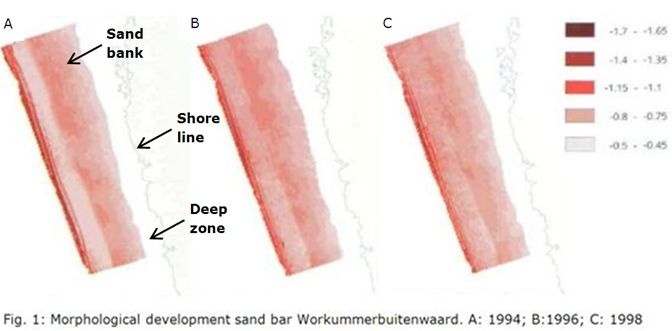Operation and Maintenance
The Workumerbuitenwaard project was not successful in reaching its objectives. As expected, the nourished sand remained permanently submerged after a short period of time. The fact that the sand bar was not protected by artificial structures led to erosion and stimulated sand transport. In this particular case, however, waves transported the sand westward into deeper water, instead of eastward to the coast. Part of the sand was transported by currents to the north, where it was deposited in shallow water. Shoreward transport turned out to be rather small.
The observed effects after construction are in more detailed described in the following sections:
- Monitoring data
- Morphology
- Ecology
- Effects future developments (rising water level)
- Conclusion
1.Monitoring data
Monitoring data combined with field observations from 1994, 1996 and 1998 show that there has been none or little sand transport in the direction of the coast. The deeper zone directly west of the bar, however, had become much shallower. The sand bar itself had lost height under the prevailing conditions between 1992 and 1998 (see figure).

2.Morphology
Erosion of the sand bar occurred as predicted. However, the direction of transport was different from the expectation. Instead of moving towards the coast, the sand was transported in northern direction and to deeper areas in the west. This shows that steering of dynamic processes like sand transport is difficult and that specific knowledge is needed to predict this. However, on a larger scale the sand nourishment at Workumerbuitenwaard did contribute as it led to sedimentation at other places (e.g. ‘t Gaast) along the IJsselmeer coast. If the sand bar would have been placed higher on the shoreface and if sediment-trapping groynes would have been used, more sand might have ended at the intended locations.
3.Ecology
The sand nourishment has indirectly contributed to nature values, be it at other locations than intended. Nature and extent of the effects on specific habitat types, however, are less clear. The nourishment seems to have contributed to the development of aquatic plants in its direct surroundings, while the effects at the location of the nourishment itself seem to be very limited. The submerged sand bar hardly contributes to Natura2000 objectives for bird species. Yet, there is a positive effect on the occurrence of stonewort (green algae of the class Charophyceae) which contributes to both Natura 2000 and the EU Water Framework Directive.
4.Effects future developments (rising water level)
In case of rising water levels, the influence of waves and currents will increase. This can lead to further erosion of the remaining parts of the sand bar, which subsequently can lead to increased pressure on the coast.
5.Conclusion
The conclusion is that sand nourishments in this type of shallow lake environment do not automatically lead to shoreward transport and sediment supply to the coast. In this particular case, most of the sediment is being transported. Consequently, the sand nourishments at Workumerbuitenwaard did not result in shoreline accretion, nor in deposition on terrestrial areas.
